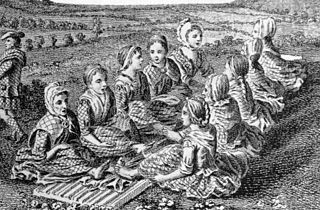
Calico is a plain-woven textile made from unbleached and often not fully processed cotton. It may contain unseparated husk parts, for example. The fabric is far less fine than muslin, but less coarse and thick than canvas or denim, but it is still very cheap owing to its unfinished and undyed appearance.

Carding is a mechanical process that disentangles, cleans and intermixes fibres to produce a continuous web or sliver suitable for subsequent processing. This is achieved by passing the fibers between differentially moving surfaces covered with card clothing. It breaks up locks and unorganised clumps of fibre and then aligns the individual fibers to be parallel with each other. In preparing wool fibre for spinning, carding is the step that comes after teasing.
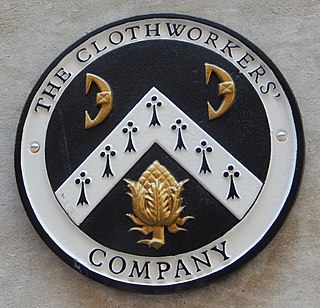
The Worshipful Company of Clothworkers was incorporated by Royal Charter in 1528, formed by the amalgamation of its two predecessor companies, the Fullers and the Shearmen. It succeeded to the position of the Shearmen's Company and thus ranks twelfth in the order of precedence of Livery Companies of the City of London.
Plush is a textile having a cut nap or pile the same as fustian or velvet. Its softness of feel gave rise to the adjective "plush" to describe something soft or luxurious, which was extended to describe luxury accommodation, or something rich and full.
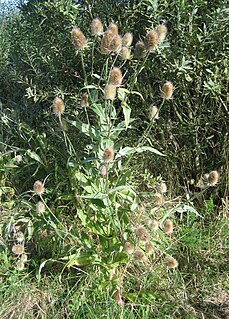
Dipsacus is a genus of flowering plant in the family Caprifoliaceae. The members of this genus are known as teasel, teazel or teazle. The genus includes about 15 species of tall herbaceous biennial plants growing to 1–2.5 metres (3.3–8.2 ft) tall. Dipsacus species are native to Europe, Asia and northern Africa.
Flannel is a soft woven fabric, of various fineness. Flannel was originally made from carded wool or worsted yarn, but is now often made from either wool, cotton, or synthetic fiber. Vegetable flannel is made from Scots pine fibre.
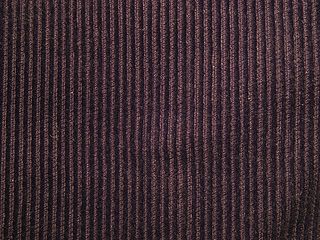
Corduroy is a textile with a distinct pattern, a "cord" or wale. Modern corduroy is most commonly composed of tufted cords, sometimes exhibiting a channel between the tufts. Both velvet and corduroy derive from fustian fabric.

Pile weave is a form of textile created by weaving.These fabrics are characterized by a pile, a looped or tufted surface that extends above the foundation or ground weave. The pile is formed by supplemental yarn running in the direction of the length of the fabric or the width of the fabric. Pile weaves include velvet and corduroy fabrics and machine-woven Berber carpets.

Dipsacus fullonum, syn. Dipsacus sylvestris, is a species of flowering plant known by the common names wild teasel or fuller's teasel, although the latter name is usually applied to the cultivated species Dipsacus sativus. It is native to Eurasia and North Africa, but it is known in the Americas, southern Africa, Australia and New Zealand as an introduced species and often a noxious weed. It forms large monocultures in areas it invades that have favorable climates and none of its biological control species. The inflorescence is a cylindrical array of lavender flowers which dries to a cone of spine-tipped hard bracts. It may be 10 centimeters long.

Broadcloth is a dense, plain woven cloth, historically made of wool. The defining characteristic of Broadcloth is not its finished width, but the fact that it was woven much wider and then heavily milled in order to shrink it to the required width. The effect of the milling process is to draw the yarns much closer together than could be achieved in the loom and allow the individual fibres of the wool to bind together in a felting process. This results in a dense, blind face cloth with a stiff drape which is highly weather-resistant, hard wearing and capable of taking a cut edge without the need for being hemmed.

A raising card is used to raise cloth. Raising is the technique used to produce the nap of cloth. Originally, only woolen cloth was raised, but now flannelette and other cotton fabrics are also raised. Raising is one of the last steps in the finishing process for cloth. It teases out the ends of the fibers in the cloth to produce a nap.
The manufacture of textiles is one of the oldest of human technologies. To make textiles, the first requirement is a source of fibre from which a yarn can be made, primarily by spinning. The yarn is processed by knitting or weaving, which turns yarn into cloth. The machine used for weaving is the loom. For decoration, the process of colouring yarn or the finished material is dyeing. For more information of the various steps, see textile manufacturing.
In the history of textiles, frieze is a Middle English term for a coarse woollen, plain weave cloth with a nap on one side. The nap was raised by scrubbing it to raise curls of fibre, and was not shorn after being raised, leaving an uneven surface. Panni frisi, "Frisian cloths", appear in medieval inventories and other documents. Frieze was woven in the English Midlands and Wales, and in Ireland from the fourteenth century, and later in Holland as well. A similar textile is baize. In Old Norse, such cloth was called vaðmál (wadmal), and lengths of wadmal were a medium of exchange, especially for the poor who had neither cattle nor silver. Wadmal could be used to pay property tax.

In textile manufacturing, finishing refers to the processes that convert the woven or knitted cloth into a usable material and more specifically to any process performed after dyeing the yarn or fabric to improve the look, performance, or "hand" (feel) of the finish textile or clothing. The precise meaning depends on context.

A loden cape is an overcoat of Tyrolean origin, made of a thick, water-resistant woolen material with a short pile, first produced by peasants in Austria. The fabric is derived from the coarse, oily wool of mountain sheep and has a traditional bluish-green colour. The name is derived from Middle High German 'lode' or from Old High German 'lodo', meaning 'coarse cloth'.
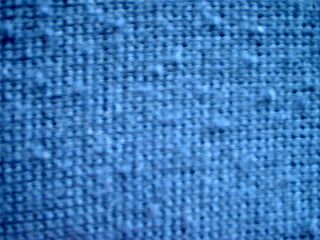
A pill, colloquially known as a bobble, fuzzball, or lint ball is a small ball of fibers that forms on a piece of cloth. 'Pill' is also a verb for the formation of such balls.








